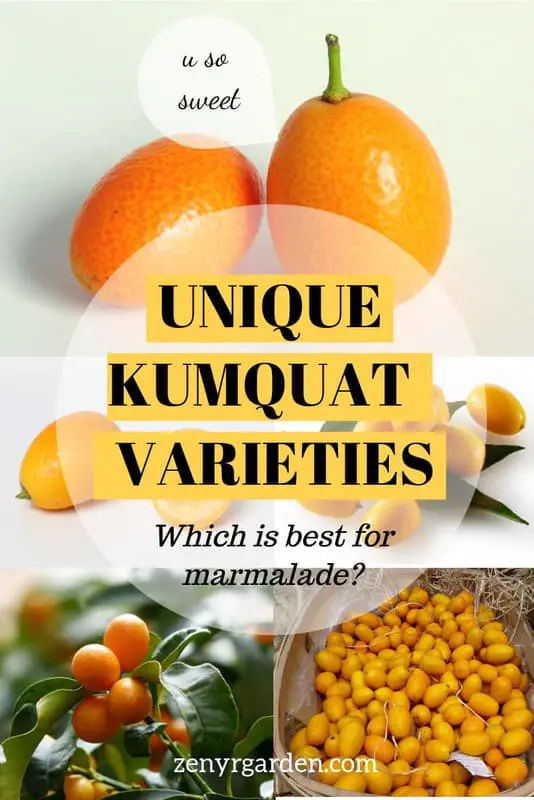So you're just getting started exploring the fun world of kumquats and wanted to learn more about this amazing tree? C'mon along, let's check out these cool varieties together.
The first variety we'll be checking out is:
1. Meiwa (The Sweet Variety)
/meiwa-kumquat-fruit.jpg)
Meiwa, or Fortunella crassifolia, is hands-down the sweetest variety of all the kumquats. The shape of its fruit is more round & up to 1.5 inches (3.8 cm) in diameter.
This variety flowers in the summer & bears fruits late in the winter. Thanks to its semi-dormant characteristic, the tree can withstand extreme temperatures below the freezing point.
The skin of meiwa is thick, oftentimes thicker than the nagami variety (another variety that we will see in just a moment).
Meiwa flesh is sweet, light orange and has one or two seeds.
/inside-sweet-meiwa-kumquat.jpg)
You can eat the whole fruit or either the rind or flesh as you like.
In contrast to Meiwa the sweet one, we'll now see Nagami the sour variety next:
2. Nagami (The Sour Variety)
/nagami-kumquat-tree.jpg)
Nagami, or Fortunella margarita, has sweet skin & sour juice. For folks who love a good balance of sweet-n-sour goodness, this variety taste is truly heaven to them.
To tell nagami from meiwa, you can look at the shape of the fruit. Nagami has a more oval shape (like an olive) while meiwa fruit is more round.
Like meiwa, this variety is ridiculously cold-hardy. It flowers from July to August & bears fruits in the late winter.
This is a prolific bearer that can give you fruits all year round. Kumquat fruits have tons of vitamins & can strengthen the immune system.
/inside-sour-nagami-kumquat.jpg)
People usually use the nagami to make marmalade & jellies because of its natural tartness.
This short video compares Meiwa vs Nagami:
>> Link YouTube:
Meiwa kumquat vs. Nagami kumquatThe third variety of kumquat we may see is:
3. Fukushu (The Thin Skin Variety)
/fukushu-kumquat-tree.jpg)
Fukushu, or Fortunella obovata, is a thin skin hybrid between two Fortunella species. Its fruits are larger than the other species we've seen.
Fukushu's small form with spreading round leaves makes it a cute ornamental shrub. Like nagami, this baby has sweet edible peel with tart pulp.
In the summer, it blooms white, exquisitely fragrant flowers. The fruits ripen at year end. People also call this variety Chang Shou kumquat. Although they sound different, it's basically the same variety. Fukushu is the Japanese name and Chang Shou is the Chinese name.
Fukushu can withstand temperatures as low as 28F (-2C) on its own with little or no protection. Thus, making it a low-maintenance choice even for colder growing zones.
Here is the smallest variety of kumquat:
4. The Golden Bean (The Smallest Fruit)
/golden-bean-kumquat-tree.jpg)
Golden Bean or Hong Kong kumquat (Fortunella hindsii) is the smallest one in the kumquat family. Their fruits rarely grow more than 1.5 inches (3.8 cm) in diameter.
This variety can be started from seeds more easily than the other ones. Their fruits have large seeds & with very little flesh, thus making them not highly edible.
This is why many people grow Golden Beans mostly indoors as an ornament or as a novelty.
/golden-bean-kumquat-plant.jpg)
The Variety That You Like
For kumquat, the varieties that many folks hunt down for are the meiwa & nagami. Local grocery stores don't usually have these little treasures. And if they do carry some, their prices are usually really expensive.
There's a reason folks call these kumquats "winter super fruit". In a little kumquat, there's only about 63 calories. With its low sugar content & great source of vitamin A, C, and fiber, this super fruit can be enjoyed by everyone including Type 1 & Type 2 diabetics.
Meiwa or Nagami?
If you often forget the meiwa from the nagami (like us sometimes), just remember: Where's the dub (aka the W)? If there's a dub, then it's sWeet, so it must be meiWa. The other one (nagami) is the sour one. But if you don't like the tartness of nagami, just eat the sweet rind & squirt out the juice.
Hope this brief post has given you some ideas about the different kumquat varieties. We'll play around more with these citrus fruit trees. Come back often to check out more goodness. See y'all next time.
Responses to Readers' Questions
Do you ever have Golden Bean kumquat trees available? Or, is it possible to get seeds?
--> Hello, thanks for your question. We have not the Golden Bean kumquat trees available yet. However, I have seen some selling the seeds on ebay. Perhaps you could have a look. I'll keep this in mind and get back to you if I find anything useful. See you next time!
(Update 11 Oct 2022): You can see more here:
I believe he is in Hawaii. Not sure if they still grow it in their backyard. You may have a chat to see if they could kindly mail you a few. I hope this helps!
Share or pin this post!


